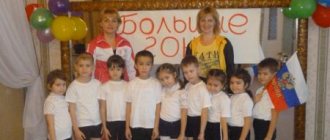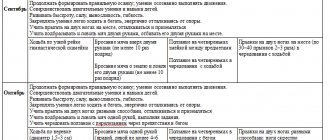Conducting physical education while walking. Consultation for educators
Yulia Nikolaevna Portyannikova
Conducting physical education while walking. Consultation for educators
Carrying out physical education while walking
Consultation for educators
Physical exercise during a walk contributes to the development of the cardiovascular, respiratory, muscular and other important body systems of children. This is achieved by including outdoor games , relay races, sports exercises, various types of running, and exercises in basic movements in classes. During physical education classes during a walk, there is a constant alternation of activities: more intense exercises alternate with less intense ones, which allows children to maintain high performance throughout the entire lesson , for example, slow running is replaced by a game, a game is replaced by an exercise in the main movement, etc.
One of the features of walking classes is that general developmental exercises are carried out not in a row , but in different parts of the lesson : in the introductory-preparatory class, while walking, children perform various hand movements, slow running alternates with jumping; In the main part, exercises are given to develop the legs and torso. Such implementation of general developmental exercises saves time and makes the lesson more dynamic .
Another feature of outdoor activities is teaching children sports games and exercises: jumping rope, skiing. In the senior group, children learn the elements of basketball, football, and learn to play badminton. In addition, during walking exercises , children consolidate the basic movements that they learned in previous physical education classes .
A physical education lesson during a walk consists of three interconnected parts: introductory-preparatory, main, and final.
The introductory and preparatory part is designed to help organize children and create their mood for the upcoming physical activity.
The introductory – preparatory part begins with formation and walking. While walking, children perform simple hand movements. While walking, the teacher monitors a clear step, correct hand movements, and maintaining distance. Walking without stopping turns into a slow run, which lasts from 1 to 3 minutes, depending on the age of the children. On the second – third circle, children perform exercises (3-4)
: they run sideways with an extended step, raising their knees high, jump on one or two legs, run backwards, etc. Slow running ends with walking.
The preparatory part takes from 3 to 5 minutes. During the cold period of the year, formation is not carried out at the beginning of the lesson : upon leaving the room, children go to the sports ground, performing movements for their hands.
The main part of the lesson lasts from 14 to 26 minutes. This part solves the problems of increasing the functional capabilities of children’s bodies, developing strength, speed, and general endurance. In addition, basic movements are consolidated and the ability to use them in gaming activities is developed.
In the middle group, the main part begins with an active, plotless game, followed by a short run (within 1 minute) at an average pace. After this, children master sports exercises or perform one of the basic movements. This part ends with a plot-based active game.
In the older group, the main part begins with mastering sports exercises or elements of sports games. Then – a short jog at an average pace (from 1 to 1.5 minutes)
.
At the end of it, children practice the basic movement. After this, a run is given at an average pace, then an outdoor game is played .
In the preparatory group, the main part proceeds in the same way as in the senior group, but the teacher more often uses the group method, which makes it possible to combine the teaching of children by a teacher and the children’s independent improvement of acquired skills.
In the senior and preparatory groups, running can become more difficult - children are offered a route with overcoming obstacles.
When performing basic movements, sports exercises or elements of sports games, one should not rush - one must demand clarity and completeness of movements.
The main part of the lesson ends with an outdoor game. In order to increase the motor activity of children, losers leave the game for no more than one repetition. There should be no long stops in the game, breaks between repetitions are 15-20 seconds.
In the final part, a slow run is carried out , turning into walking. Its duration is regulated by the teacher depending on the activity of the children in the previous outdoor game, weather conditions and the readiness of the children: after a game of high mobility, the duration of the slow run should be halved or it should not be carried out at all , and the children will calmly walk around the playground. After a game of average mobility, especially in the cold season, slow running is given in the same volume as at the beginning of the lesson .
Throughout the lesson, children run a lot . In terms of speed, preschoolers can roughly be divided into three types of running: slow, at an average pace and fast.
Slow running is an important means of developing endurance in children. To teach children to run slowly, you need to gradually speed up walking.
Running at an average pace places higher demands on the activity of the body's most important systems. As studies have shown, children in the middle group are able to run at an average pace without stopping from 500 to 600 meters, and in the preparatory group - from 7 to 900 meters.
Fast running is an integral part of games, relay races; for preschoolers it is carried out at a distance of 10 to 30 meters.
When exercising outdoors, you need to pay attention to nasal breathing. At the same time, you should not be afraid if children breathe through their mouths during the cold season while running or playing.
Children's clothing and shoes during outdoor activities


